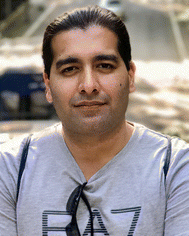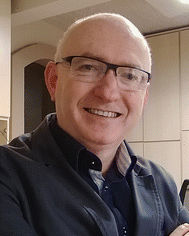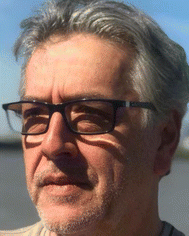50th anniversary of ICCST: celebrating ICCST at its 15th edition
Jamal
Rafique
 *ab,
Eder J
Lenardão
*ab,
Eder J
Lenardão
 *c and
Antonio L.
Braga
*c and
Antonio L.
Braga
 *d
*d
aInstitute of Chemistry, Federal University of Mato Grosso do Sul, Campo Grande, 79074-460, MS, Brazil. E-mail: jamal.rafique@ufms.br; jamal.chm@gmail.com
bInstituto de Química, Universidade Federal de Goiás, Câmpus Samambaia, Goiânia, 74690-900, GO, Brazil. E-mail: jamal@ufg.br
cCenter of Chemical, Pharmaceutical and Food Sciences, Universidade Federal de Pelotas, Pelotas, 96010-900, RS, Brazil. E-mail: lenardao@ufpel.edu.br
dDepartment of Chemistry, Federal University of Santa Catarina, Campus Trindade, 8804-900, Florianópolis-SC, Brazil. E-mail: braga.antonio@ufsc.br
 Jamal Rafique |
 Eder J Lenardão |
 Antonio L. Braga |
After the discovery of selenium (by Berzelius in 1817), there was limited research into its chemistry due to the taboo that selenium-containing compounds are smelly and toxic. It's actually the low molecular weight aliphatic molecules that are smelly, like the first organoselenium compound, diethyl selenide (Et2Se), synthesized in 1836 by Henri Deville.1 For several decades the reactivity and applications of this class of compounds was not well understood. However, discoveries in 1957 on the importance of selenium as an essential trace element in the animal diet and its crucial role in the health of mammalians were a turning point.2 Also, around the same time, several selenoenzymes were discovered, attracting the attention of the scientific community to study the chemical and biochemical behaviour of selenium and its compounds.3 In the ‘50s, researchers started to explore the unique properties and reactivity of organoselenium compounds. It was observed that these compounds can be involved in a series of interesting chemical transformations, including radical, electrophilic and nucleophilic reactions. In the following decades, organoselenium compounds were found to be effective catalysts for a range of organic reactions, such as cyclization, oxidation and reduction.3 In 1973, it was discovered that selenium is present in the reactive site of mammalian glutathione peroxidase (GPX-1) enzyme, as a component of the 21st amino acid, selenocysteine. GPX-1 is involved in removing peroxides and serves as part of the antioxidant defense system of organisms.4 This discovery sparked interest in the potential therapeutic applications of organoselenium compounds in medicine.
Although the next member of the chalcogen family, tellurium, was discovered earlier than selenium (by von Reichenstein in 1782) for around two centuries it was rarely explored.5
For a very long period, research on tellurium compounds suffered the same dilemma as of selenium. Although the first organotellurium compound was prepared by Wohler in 1840, research on tellurium chemistry was at its lowest pace, e.g., only about 50 papers were published on tellurium chemistry between 1910 and 1950.6 The main reason was that much of tellurium research was pursued as an extension of selenium chemistry. However, after works published in the ‘70s, it was observed that the chemical behaviour of both these elements (Se and Te) has several dissimilarities.5,6 This observation resulted in an increasing interest in tellurium chemistry over the coming decades.
Considering the growing interest in Se and Te chemistry among the scientific community, Wolfgang H. H. Gunther and Yoshiyuki Okamoto planned, in 1970, the organization of a symposium, in order to unite the community on a single platform. On March 22–23, 1971, a program of 23 papers was assembled, and the first edition of the International Conference on the Chemistry of Selenium and Tellurium (ICCST) was held in New York.7 Researchers from Latin America, Europe, and Asia participated in the first edition. Different aspects of the chemistry involving selenium and tellurium, from small molecules to biomolecules and materials, were addressed in the meeting and the content of the event was published as a complete volume in the Annals of the New York Academy of Sciences, in 1972.7,8 After the first event success, the community unanimously agreed to have regular ICCST meetings, which provided a platform to reunite the scientific community working on Se and Te chemistry.9
After the 14th edition of ICCST in Italy (2019),10 the 15th edition was programmed for Brazil (2022), which was also the 50th anniversary of ICCST. In the 15th edition of ICCST, which took place between November 28 and December 2, 2022 at the Jurerê Beach Village hotel, one hundred and ninety participants from around the world gathered in Florianópolis, the state capital of Santa Catarina, Brazil. Researchers from Brazil, Japan, Italy, Germany, Slovenia, Denmark, Korea, Romania, Canada, India, Poland, Argentina, Russia, and the USA presented their most recent results in the chemistry and biochemistry of selenium and tellurium compounds.11
The event involved 22 flash presentations (young researchers and PhD students), 30 oral presentations (plenary, invited and short ones), and 165 poster presentations, all accompanied by interesting and rich discussions. Besides, there was the launch of the book Chalcogen Chemistry: Fundamentals and Applications, published by the Royal Society of Chemistry and edited by V. Lippolis, C. Santi, E. J. Lenardão, and A. L. Braga.12 Finally, a tribute was paid to the creator of the ICCST, Prof. Gunther. His legacy will live on in the Se and Te community through the institution of the Wolfgang Gunther Prize, to be awarded for the first time at the next ICCST in Germany.
The state of the art on the chemistry of selenium and tellurium regarding organic, inorganic, materials science, theoretical, spectroscopy, and biochemistry aspects were featured at this amazing event. As a peculiarity of the Brazilian chemical community, the participation of undergraduate students was encouraged, including subsidies in the registration fee. This provided young students with a unique opportunity to interact with some of the greatest exponents of Se and Te chemistry worldwide.
As expected from a good international congress, new collaborations and interactions were sown at ICCST-15, and we expect this to reap benefits soon, which will be presented in 2025 in Halle, Germany, at ICCST-16.
The focus of this 50th-anniversary edition of the ICCST themed collection is the compilation of the published data by the scientific community in the Royal Society of Chemistry journal portfolio, who as a Society have actively participated in ICCST since the last edition in Italy (in 2019). Further contributions after the 50th anniversary of ICCST are going to be added to this themed collection.
References
- J. B. T. Rocha, B. C. Piccoli and C. S. Oliveira, ARKIVOC, 2017, 475 Search PubMed.
- U. Schweizer and N. Fradejas-Villar, FASEB J., 2016, 30, 3669 CrossRef CAS PubMed.
- C. W. Nogueira, N. V. Barbosa and J. B. T. Rocha, Arch. Toxicol., 2021, 95, 1179 CrossRef CAS PubMed.
- V. M. Labunskyy, D. L. Hatfield and V. N. Gladyshev, Physiol. Rev., 2014, 94, 739 CrossRef CAS PubMed.
- L. Engman, Acc. Chem. Res., 1985, 18, 274–279 CrossRef CAS.
- J. V. Comasseto, J. Braz. Chem. Soc., 2010, 21, 2027 CrossRef CAS.
- W. H. H. Gunther, Phosphorus, Sulfur Silicon Relat. Elem., 2001, 171, 1 CrossRef.
- W. H. H. Gunther, Phosphorus, Sulfur Silicon Relat. Elem., 2008, 183, 819 CrossRef CAS.
- https://www.iccst.org/ (visited 10th July 2023).
- V. Lippolis and C. Santi, New J. Chem., 2019, 43, 11032 RSC.
- https://iccst15.com.br/ (visited 10th July 2023).
- Chalcogen Chemistry: Fundamentals and Applications, ed. V. Lippolis, C. Santi, E. J. Lenardão and A. L. Braga. Royal Society of Chemistry, Croydon, UK, 2023 Search PubMed.
| This journal is © The Royal Society of Chemistry and the Centre National de la Recherche Scientifique 2023 |
